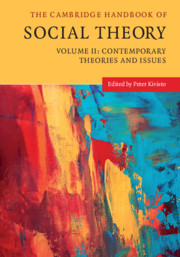Book contents
- The Cambridge Handbook of Social Theory
- The Cambridge Handbook of Social Theory
- Copyright page
- Contents
- Figures
- Tables
- Contributors
- Preface
- 1 Rational Choice Theory and Methodological Individualism
- 2 Network Theories
- 3 Cultural Sociology
- 4 Identity
- 5 Emotions Theory
- 6 Theorizing Sex/Gender: Feminist Social Theory
- 7 Intersectionality as Critical Social Theory
- 8 Modernity
- 9 Realism
- 10 Globalization: Not Good, Bad, or Over
- 11 Time/Space
- 12 Social Theory in the Anthropocene: Ecological Crisis and Renewal
- 13 Embodiment
- 14 Sexualities
- 15 Multiculturalism
- 16 Risk
- 17 Trust and the Variety of Its Bases
- 18 Unities Within Conflict: Mapping Biology’s Relevance to Sociological Theory
- 19 Civil Society
- 20 Social Movements: Sequences vs Fuzzy Temporality
- 21 Immigration
- Index
- References
13 - Embodiment
Published online by Cambridge University Press: 03 December 2020
- The Cambridge Handbook of Social Theory
- The Cambridge Handbook of Social Theory
- Copyright page
- Contents
- Figures
- Tables
- Contributors
- Preface
- 1 Rational Choice Theory and Methodological Individualism
- 2 Network Theories
- 3 Cultural Sociology
- 4 Identity
- 5 Emotions Theory
- 6 Theorizing Sex/Gender: Feminist Social Theory
- 7 Intersectionality as Critical Social Theory
- 8 Modernity
- 9 Realism
- 10 Globalization: Not Good, Bad, or Over
- 11 Time/Space
- 12 Social Theory in the Anthropocene: Ecological Crisis and Renewal
- 13 Embodiment
- 14 Sexualities
- 15 Multiculturalism
- 16 Risk
- 17 Trust and the Variety of Its Bases
- 18 Unities Within Conflict: Mapping Biology’s Relevance to Sociological Theory
- 19 Civil Society
- 20 Social Movements: Sequences vs Fuzzy Temporality
- 21 Immigration
- Index
- References
Summary
The “rise of embodiment” has been one of the most significant developments in social theory over the past thirty years, and this chapter examines the historical context for this (re)turn to carnality before interrogating the ambiguities of recent perspectives that risk losing sight of the enfleshed actor.Identifying the need for a counterweight to these strong constructionist and materialist orientations, I suggest that revisiting creatively the notion of the body schema enables us to pursue different theoretical options, while saving from analytical conflation the facticity of embodied subjects.
Body schema, classical sociology, embodiment, identity, mind/body dualism
Dr. Chris Shilling is Professor of Sociology at the School of Social Policy, Sociology, and Social Research (SPSSR), University of Kent.He has published extensively in the areas of sociological theory and religion, and is one of the main figures in the development of “body studies.” His recent books include The Body and Social Theory, 3rd edition (2012), The Body: A Very Short Introduction (2016), and with P. A. Mellor, Sociology of the Sacred (2014) and Uncovering Social Life: Critical Perspectives from Sociology (2018).
- Type
- Chapter
- Information
- The Cambridge Handbook of Social Theory , pp. 249 - 271Publisher: Cambridge University PressPrint publication year: 2020
References
- 5
- Cited by

